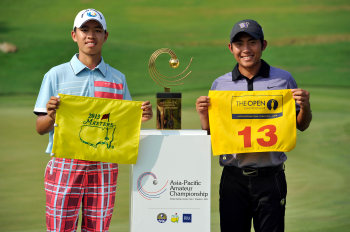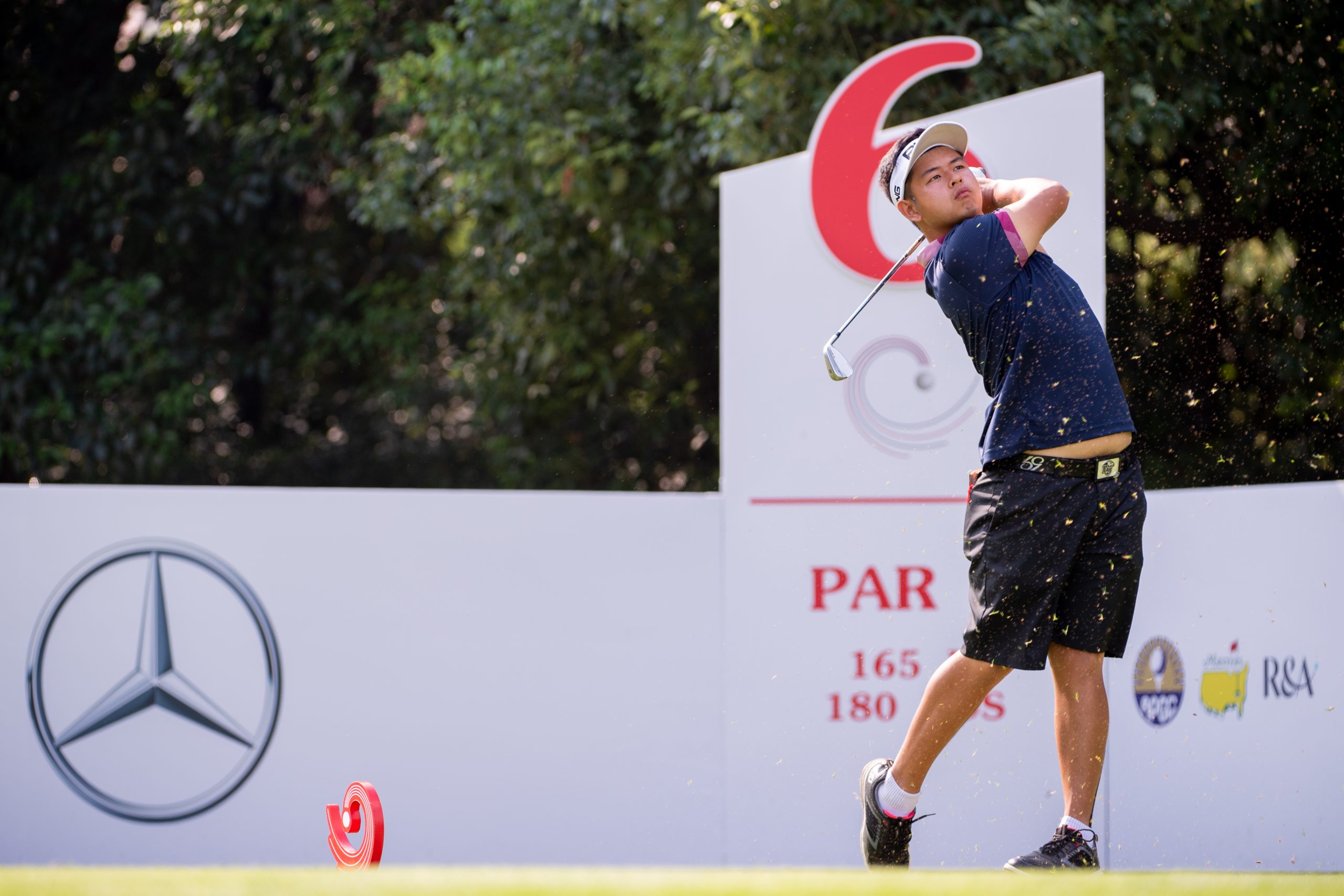Since its inception in 2009, the Asia-Pacific Amateur Championship (AAC) has served as a springboard to great success for its participants. Next month, a new group of players will look to establish their legacy at the AAC from October 27-30 and follow the footsteps of elite players that have competed over the years.
Among the achievements by past competitors: two major championships; 102 victories across the PGA Tour, DP World Tour, Asian Tour, and Japan Golf Tour; five players on top of the World Amateur Golf Ranking (WAGR) and 11 climbing into the top-50 of the Official World Golf Ranking (OWGR).

Hideki Matsuyama of Japan is awarded the Masters Trophy and the Green Jacket during the Green Jacket Presentation Ceremony following the final round of the Masters at Augusta National Golf Club, Sunday, April 11, 2021.
A whole ecosystem needs to collaborate to produce a champion, but certain ingredients can serve as a catalyst to the process. From the days of Peter Thomson and Isao Aoki, the Asia-Pacific region has been a hotbed of golf talent, but most players either bloomed late in their careers, or they did not venture out of their geographical territories, usually due to a lack of opportunity.
When the AAC was established in 2009 by the Masters Tournament, The R&A and the Asia Pacific Golf Confederation (APGC), it was a game-changing moment for a majority of amateurs in the region. Playing at the Masters and The Open was just a dream. The AAC helped turn that into a reality. The players now had a chance of playing in a Championship that drew the attention of golf officials, fans, media and college coaches worldwide early in their careers.
Current Malaysian number one Gavin Green was among the players who teed up in the inaugural AAC at Mission Hills Golf Club in Shenzhen, China. Then only 15, he missed the cut but nonetheless holds the Championship in high esteem.
“I think the Asia-Pacific Amateur Championship is an event that everyone should play in during their amateur careers if they are given the opportunity to do so. The AAC gives you a rare chance to test yourself against the best in the world,” said Green, who became the first and to-date only Malaysian to top the Asian Tour Order of Merit in 2017.
Joining the paid ranks in 2015 following a standout U.S. collegiate golf career with the University of New Mexico, Green has four international professional titles to his name including the 2017 Mercuries Masters in Chinese Taipei. The long-hitting 28-year-old recently came close to winning his maiden title on the DP World Tour (European Tour) with a runner-up finish in the Czech Masters.
The end of the 2000s was a defining moment for the region. More players from the Asia-Pacific region started making their mark on world golf. Many metrics exist for gauging success, including international wins. Intangibles stemming from the creation of the AAC, including a surge in motivation and confidence, were also a factor.
It did not take long for the AAC to find its first star. Japan’s Hideki Matsuyama earned back-to-back wins at the 2010 and 2011 AAC on his way to becoming the No. 1 amateur in the world, the first Japanese player to reach the pinnacle of amateur golf. Matsuyama’s story so far has been inextricably linked to the AAC. His 2010 win earned him a spot into the 2011 Masters, and he immediately made an impact by earning Low Amateur honours. Soon after, he won a professional title on the Japan Golf Tour as an amateur, and while he has won seven other PGA Tour events since, his crowning achievement was his emotional win at the 2021 Masters, making him the first Asian-born player to don the Green Jacket and bring his AAC journey full circle.

Australia’s Cameron Smith put together a clutch performance on the back nine on Sunday to win the historic 150th Open at St Andrews.
“I don’t think I would have made it to the Masters without the Asia-Pacific Amateur Championship,” said Matsuyama, who is looked upon as the “senpai” (leader who motivates) by young Japanese players. “I was upset I did not win it for a third time [in 2012 at Amata Spring Country Club in Thailand, host venue of this year’s Championship], but I think that frustration kind of gave me the motivation to play professionally the following year.”
Less than 15 months after Matsuyama’s Masters triumph, another AAC alumni made his country proud by becoming a major winner. Australia’s Cameron Smith put together a clutch performance on the back nine on Sunday to win the historic 150th Open at St Andrews.
In 2011, Smith had finished fourth in his AAC debut, three shots behind champion Matsuyama, his playing partner in the final round. He was tied seventh at the 2012 edition in Amata Spring.
“I remember my first Asia-Pacific Amateur; I played with Hideki in the last group, and he ended up winning the tournament,” recalled Smith. “He was probably the first player I played with that I really thought was the best player in the world. He was hitting iron shots, shaping it into different pins. He was really the first guy that I saw doing that. Lots of good memories there.”
The player who denied the two superstars with a victory in 2012 was 14-year-old Tianlang Guan of China. When Guan became the youngest-ever player to make the cut the following April at Augusta National – despite enduring a one-shot penalty – he further legitimized the efforts of the founding partners in creating the AAC.

Guan Tianlang and C.T. Pan
In 2021 alone, three AAC alumni – Korea’s Kyoung-Hoon Lee (AT&T Byron Nelson), Australia’s Cameron Davis (Rocket Mortgage Classic) and Australia’s Lucas Herbert (Bermuda Championship) – added PGA Tour wins to their resume. Lee and Davis will make their debut at the Presidents Cup later this month, alongside fellow AAC alumni Matsuyama and Si Woo Kim.
“The AAC has helped me grow for a long period, and it was also part of my foundation to be able play solid on the PGA Tour now,” reflected Chinese Taipei’s C.T. Pan, who was runner-up to Guan in 2012 and went on to win on the PGA Tour and earn a bronze medal at the Tokyo Olympics. “The AAC has become the most influential amateur tournament in the Asia-Pacific region, and I am very happy to see that today’s generation get such an amazing opportunity to play on such a big stage and shine.”
While both Matsuyama and Smith have risen to as high as No. 2 in the OWGR, equally impressive is the fact that five players – Matsuyama, Takumi Kanaya, Keita Nakajima, Curtis Luck and Chun An Yu – have become top-ranked amateur players in the world after their appearances in the AAC. Pan also spent time as the top-ranked amateur prior to his debut at the AAC.
Rookie professional Ervin Chang jointly holds the Malaysian record for best finish in the AAC, thanks to his seventh-place performance in the 2018 Championship at Sentosa Golf Club in Singapore. Having played in four AACs (2014, 2015, 2018 and 2019), he describes the Championship as the “ultimate event” for amateurs.
“There are so many things that I like about the Asia-Pacific Amateur Championship. It always showcases awesome hospitality, challenging course set-ups, committed volunteers, a top-class field, and, most importantly, gives us a chance to play in The Open and the Masters Tournament,” said the 24-year-old, who played on the U.S. collegiate golf circuit with much success for Liberty University from 2016 to 2020.
Chang, who won two gold medals in the Southeast Asian Games before turning professional in June, recently chalked up his best finish on the Asian Development Tour with a runner-up performance at the OB Golf Invitational in Indonesia.
“The Asia-Pacific Amateur Championship helped prepare me for professional golf, as I was able to compete against world-class players in an environment that matches the top professional events,” noted Chang.
When the 2022 AAC is played at Amata Spring Country Club in Chonburi, the field will not be short on inspiration.
For more information about the AAC, please visit AACgolf.com.














